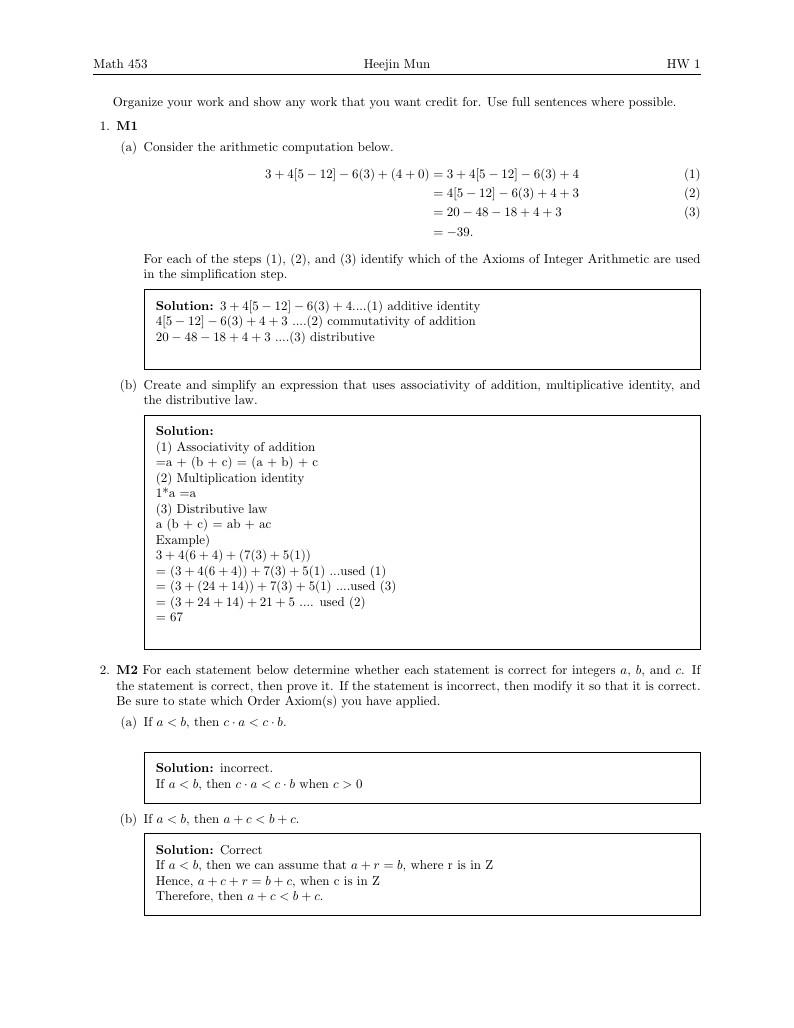
Math 453 HW 1
Author:
munh1
Last Updated:
10년 전
License:
Creative Commons CC BY 4.0
Abstract:
Math 453 HW 1 (with solutions)

\begin
Discover why over 20 million people worldwide trust Overleaf with their work.
Math 453 HW 1 (with solutions)

\begin
Discover why over 20 million people worldwide trust Overleaf with their work.
%%%%%%%%%%%%%%%%%%%%%%%%%%%%%%%%%%%%%%%%%%%%%%%%%%%%%%%%%%%%%%%
%
% Welcome to Overleaf --- just edit your LaTeX on the left,
% and we'll compile it for you on the right. If you give
% someone the link to this page, they can edit at the same
% time. See the help menu above for more info. Enjoy!
%
%%%%%%%%%%%%%%%%%%%%%%%%%%%%%%%%%%%%%%%%%%%%%%%%%%%%%%%%%%%%%%%
%\title{Math 453 HW 1}
\documentclass[addpoints]{exam}
\usepackage{amsmath,enumitem,wrapfig}
\usepackage{tikz}
\newcommand{\StudentName}{Heejin Mun}
\newcommand{\AssignmentName}{HW 1}
\pagestyle{headandfoot}
\runningheadrule
\firstpageheadrule
\firstpageheader{Math 453}{\StudentName}{\AssignmentName}
\runningheader{Math 453}{\StudentName}{\AssignmentName}
\firstpagefooter{}{}{}
\runningfooter{}{}{}
\printanswers
\begin{document}
Organize your work and show any work that you want credit for. Use full sentences where possible.
\begin{questions}
\question \textbf{M1}
\begin{parts}
\part
Consider the arithmetic computation below.
\begin{align}
3+4[5-12]-6(3) +(4+0)
&= 3+4[5-12]-6(3) +4\\
&= 4[5-12]-6(3) +4+3\\
&= 20-48-18 +4+3 \\
&=-39.\notag
\end{align}
For each of the steps (1), (2), and (3) identify which of the Axioms of Integer Arithmetic are used in the simplification step.
\begin{solution}
$3+4[5-12]-6(3) +4$....(1) additive identity\\
$4[5-12]-6(3) +4+3$ ....(2) commutativity of addition\\
$20-48-18 +4+3$ ....(3) distributive\\
\end{solution}
\part Create and simplify an expression that uses associativity of addition, multiplicative identity, and the distributive law.
\begin{solution}\\
(1) Associativity of addition\\
=a + (b + c) = (a + b) + c\\
(2) Multiplication identity\\
1*a =a\\
(3) Distributive law\\
a (b + c) = ab + ac\\
Example) \\
$3 + 4(6 + 4) + (7(3) + 5(1))$\\
= $(3 + 4(6 + 4)) + 7(3) + 5(1)$ ...used (1)\\
= $(3 + (24 + 14)) + 7(3) + 5(1)$ ....used (3)\\
= $(3 + 24 + 14) + 21 + 5$ .... used (2)\\
= $67$ \\
\end{solution}
\end{parts}
\question \textbf{M2}
For each statement below determine whether each statement is correct for integers $a$, $b$, and $c$. If the statement is correct, then prove it. If the statement is incorrect, then modify it so that it is correct. Be sure to state which Order Axiom(s) you have applied.
\begin{parts}
\part If $a<b$, then $c\cdot a< c\cdot b$.\\
\begin{solution}
incorrect.\\
If $a<b$, then $c\cdot a< c\cdot b$ when $c>0$
\end{solution}
\part If $a<b$, then $a+c<b+c$.
\begin{solution}
Correct\\
If $a<b$, then we can assume that $a + r= b$, where r is in Z\\
Hence, $a + c + r = b + c$, when c is in Z\\
Therefore, then $a+c<b+c$.
\end{solution}
\part If $a<b$, $b<c$, and $c<d$, then $a<d$.
\begin{solution}
Correct\\
with the same way part (b)\\
Since If $a<b$, then If $a+r=b$, when r is in Z\\
and $b<c$, so it follows that $b+r=c$, it is also same with $a+r+r=b+r=c$\\
also, if $c<d$, then $c+r=d$, it is same with $a+r+r+r=b+r+r=c+r=d$\\
Therefore, $a+3r=d$\\
Hence, $a<d$
\end{solution}
\part If $a\not > b$ and $a\not< b$, then $a=b$.
\begin{solution}
Given that $a\not > b$ and $a\not< b$\\
For $a\not > b$ \\
then, it can be either $a < b$ or $a=b$, but $a < b$ is a contradiction by given $a\not< b$.\\
For $a\not< b$,\\
then, it can be either $a > b$ or $a=b$, but $a > b$ is a contradiction by given $a\not> b$.\\
Therefore, $a=b$.
\end{solution}
\end{parts}
\question \textbf{M3}
\begin{parts}
\part
Find the flaw in the following argument.
\begin{quote}
To solve $x(x+4)=x(2x-8)$ we divide both sides by $x$ (or apply Theorem 1.11) to get $x+4=2x-8$. Subtract $(x-8)$ from both sides to obtain $12=x$, so the solution is $x=12$.
\end{quote}
\begin{solution}
x could be 0, so we can't divide both sides by x.
\end{solution}
\part
Find the flaw in the following argument.
\begin{quote}
To solve $x(x-4)=12$ we factor the left-hand side and set the factors equal to zero $x=0$ and $x-4=0$ and conclude that $x=0,4$.
\end{quote}
\begin{solution}
$x(x-4)=12$ should be $x^2-4x-12=0$ by distributive law\\
then, $(x-6)(x+2)=0$
Therefore, $x=6, -2$
\end{solution}
\end{parts}
\question \textbf{M4}
\begin{parts}
\part Work Exercise 1 from Investigation 1 (uniqueness of additive inverses).
\begin{solution}
If some integer a has two additive inverses, which are b and c, then we can write $a+b=0$ and $a+c=0$.\\
Then, $a+b=a+c=0$.\\
Since a is integer, we can say $b=c$
\end{solution}
\part Work Exercise 2 from Investigation 1 (additive cancellation).
\begin{solution}
Given that $a+b=a+c$, where a, b, and c are in integers Z.\\
$(-a)=(-a)$ ...(-a) exists by additive inverse.\\
Now, we can add $(-a)$ from both sides,\\
Then, $(a+(-a))+b=(a+(-a))+c$, by associative law,\\
$0+b=0+c$\\
Therefore, $b=c$ by additive identity.
\end{solution}
\end{parts}
\end{questions}
\end{document}